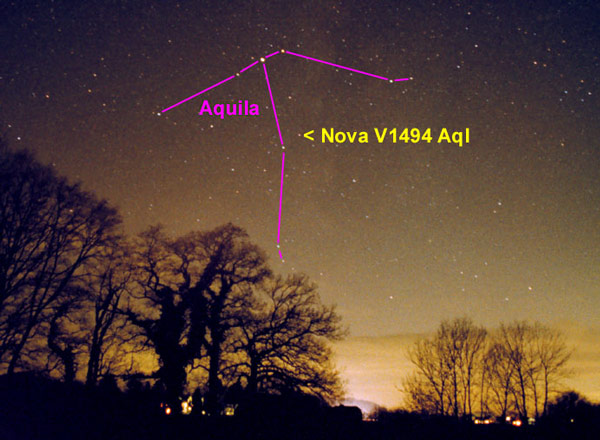
|
Credit & Copyright: Till Credner
Explanation:
On December 1st,
experienced
observers patroling the night sky
with binoculars noticed what seemed to be
a new star in the constellation
of Aquila (The Eagle).
It wasn't really a new star though.
A comparison with detailed skymaps revealed the amazing truth,
there was a known star at that position in the sky ... its brightness
had simply increased by about 70,000 times.
The star, now fondly known to
variable star observers as Nova
V1494 Aquilae, continued to grow brighter for several days,
becoming easily visible to the unaided eye before starting
to slowly fade away.
Its position within the constellation is indicated on
this wide-angle picture taken on December 4th, near the time
it was brightest.
What would cause a star to undergo such a cataclysmic change?
This "new star" appears to be a
classical nova.
Classical novae are thought to be
interacting binary star systems in which one of the pair
is a dense, hot white dwarf.
Material from the companion falls onto the surface of the white dwarf,
building up until it triggers a thermonuclear blast.
A stunning increase in brightness and an expanding shell of
debris result - but the binary system is likely not destroyed!
Classical novae are
believed to recur as the flow
of material resumes and produces another outburst
in perhaps hundreds of years time.
|
January February March April May June July August September October November December |
| ||||||||||||||||||||||||||||||||||||||||||||||||
NASA Web Site Statements, Warnings, and Disclaimers
NASA Official: Jay Norris. Specific rights apply.
A service of: LHEA at NASA / GSFC
& Michigan Tech. U.
Based on Astronomy Picture
Of the Day
Publications with keywords: nova - white dwarf - classical nova - V1494 Aquilae
Publications with words: nova - white dwarf - classical nova - V1494 Aquilae
See also:
